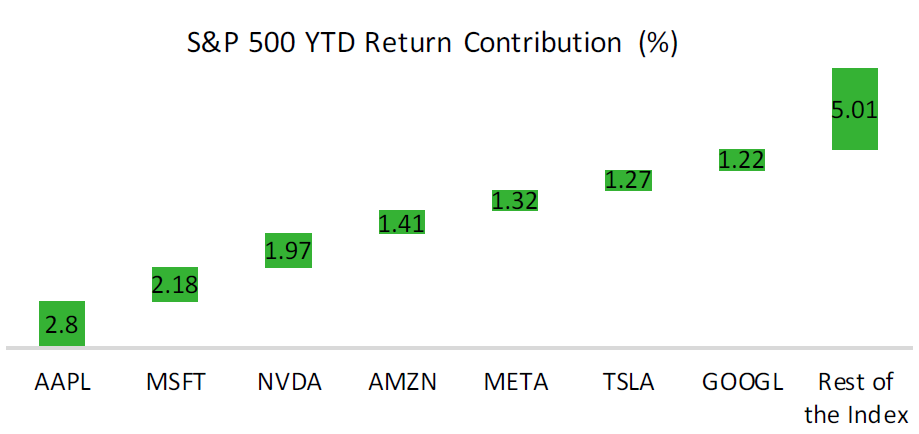Senior PM says the S&P 500 is at its narrowest in nearly three decades, which raises challenges – and opportunities

The S&P 500, the widely recognized benchmark for the U.S. stock market, consists of 500 large-cap companies across various sectors. At times, the index may experience a lack of breadth, with a handful of sectors outperforming while others lag. Currently it is the narrowest in almost 3 decades with mega technology names keeping the index buoyant.

Source: FactSet, Wealth Investment Office as of July 5, 2023
The S&P 500 index is up 16.50% year to date as of July 4th versus the Dow Jones being up 3.8% (In 2022 the Dow was down approximately half of the S&P500). Most investors, have not been fully market-cap weighted towards many of these companies. Valuations, higher interest rates, and a slowdown in the economy has temporarily tempered our enthusiasm.
If you exclude 8 of the largest technology companies, the index is up nominally on the year. While this situation can raise concerns or frustration for well diversified investors, it also presents a great opportunity to invest in underperforming sectors. What are the key reasons?
Favorable Risk-Reward Ratio
Underperforming sectors often trade at lower valuations compared to their historical averages or compared to the broader market. This provides investors with a favorable risk-reward ratio. By investing in sectors that have temporarily fallen out of favor, investors can potentially capitalize on the recovery and subsequent growth, yielding higher returns compared to investing in already overvalued sectors.
Cyclical Nature of the Market
The stock market is cyclical, with sectors taking turns in leading and lagging performance. Sectors that are currently underperforming may simply be going through a down cycle, and history has shown that these cycles tend to reverse over time. Investing in underperforming sectors during their trough can position investors to benefit from the eventual upturn, as market dynamics shift in their favor.
Diversification and Long-Term Growth
Adding exposure to underperforming sectors can enhance diversification within an investment portfolio. This environment warrants spreading investments across a range of sectors. Investors can reduce their exposure to any single sector's risks and potentially achieve more stable long-term growth.
While the lack of breadth in the S&P 500 may raise concerns, it also opens doors to exciting investment opportunities. Our viewpoint is that through careful consideration and strategic thinking, investors can navigate the market and make the most of underperforming sectors within the S&P 500 or other markets.
Additionally, we think that the Canadian market has many sectors that have compelling valuations. Canadian banks, real estate investment trusts, and energy stocks are trading at the low-end range of their historical P/E multiples yet currently have attractive fundamentals.
Bottom line: Valuations matter over the long term!
Jonathan R. Pinsler, CFA, is a senior vice president, portfolio manager, and investment advisor at TD Wealth Private Investment Advice.
The views expressed are those of Jonathan R. Pinsler, CFA, Senior Portfolio Manager, TD Wealth Private Investment Advice as of July 7, 2023, and are subject to change based on market and other conditions. Noonoo Pinsler Donato Family Wealth Management is part of TD Wealth Private Investment Advice, a division of TD Waterhouse Canada Inc. which is a subsidiary of The Toronto-Dominion Bank.



